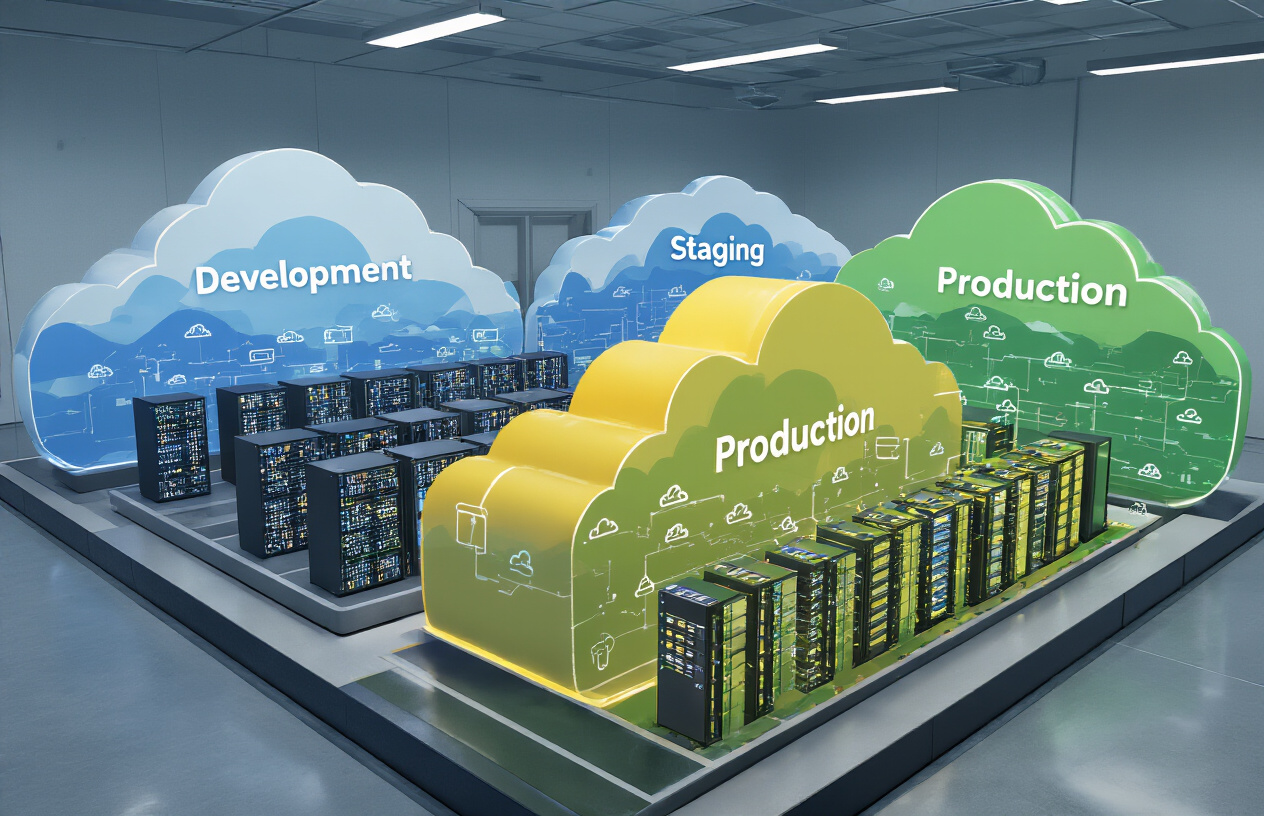AWS Amplify naming conventions can make or break your development workflow. Poor naming choices lead to confusion, deployment errors, and wasted time searching through resources. Smart AWS Amplify naming standards keep your team organized and your projects scalable.
This guide is for developers, DevOps engineers, and project managers working with AWS Amplify who want to establish clear naming rules for their team. Whether you’re building your first Amplify app or managing multiple environments across different teams, these practices will streamline your development process.
We’ll cover the essential components of AWS Amplify resource naming, including how to structure names for consistency across your entire project. You’ll learn environment-specific naming strategies that prevent mix-ups between development, staging, and production resources. We’ll also explore team collaboration naming rules that make multi-developer projects run smoothly, plus automation and deployment pipeline integration techniques that scale with your growing infrastructure.
Essential Components of AWS Amplify Resource Naming

Service Prefix Requirements for Consistent Identification
AWS Amplify resource naming begins with establishing clear service prefixes that immediately identify the application or project scope. These prefixes should be unique across your organization and follow a standardized format that includes your company abbreviation, project code, or application name. For example, using “myapp-amplify” or “companyabc-mobile” creates instant recognition of which resources belong to specific initiatives.
The prefix structure should remain consistent across all AWS Amplify resources, including APIs, authentication components, storage buckets, and Lambda functions. This consistency helps developers quickly identify resource ownership and prevents naming conflicts when multiple teams work on different projects within the same AWS account.
Consider implementing a hierarchical prefix system where the first segment identifies the business unit, the second identifies the project, and the third specifies the Amplify application. A naming pattern like “sales-crm-mobile” clearly indicates this resource belongs to the sales team’s CRM mobile application powered by AWS Amplify.
Environment Designation Patterns for Deployment Stages
Environment-specific naming strategies form the backbone of successful AWS Amplify deployment management. Each deployment stage requires distinct identifiers that prevent resource conflicts and enable smooth promotion pipelines. Standard environment designations include “dev,” “staging,” “qa,” and “prod,” integrated seamlessly into your resource names.
The placement of environment identifiers within your naming convention directly impacts automation and deployment pipeline integration. Position environment designations consistently, either as prefixes or suffixes, to maintain predictable patterns across all AWS Amplify naming standards.
| Environment | Pattern Example | Use Case |
|---|---|---|
| Development | myapp-dev-api | Individual developer testing |
| Staging | myapp-staging-api | Pre-production validation |
| Production | myapp-prod-api | Live user environment |
| QA | myapp-qa-api | Quality assurance testing |
Multiple environment variations may exist within development stages, such as “dev-john” or “dev-feature-login,” allowing developers to maintain isolated environments while following consistent AWS Amplify resource naming patterns.
Project Identifier Integration for Team Collaboration
Project identifiers bridge the gap between individual developer work and team-wide collaboration in AWS Amplify environments. These identifiers should reflect your project management structure, incorporating elements like epic names, sprint identifiers, or feature branch designations that align with your development workflow.
Integration with version control systems strengthens project identifier effectiveness. When your AWS Amplify naming conventions mirror Git branch names or Jira ticket numbers, developers can easily correlate cloud resources with code changes and project tracking systems. For instance, “myapp-dev-user-auth-1234” connects the resource to the user authentication feature and ticket number 1234.
Team collaboration naming rules should account for temporary resources created during development and testing phases. Establish clear guidelines for when developers can create personal environments and how long these resources should persist before cleanup.
Resource Type Suffixes for Clear Categorization
Resource type suffixes provide the final layer of clarity in AWS Amplify best practices for naming. These suffixes immediately identify the specific AWS service or component type, enabling quick resource identification during troubleshooting, monitoring, and maintenance activities.
Common AWS Amplify resource types require standardized suffixes that align with their function:
- APIs: Use “-api” or “-gql” for GraphQL endpoints
- Authentication: Apply “-auth” or “-cognito” for user pools
- Storage: Implement “-storage” or “-s3” for file storage
- Functions: Utilize “-fn” or “-lambda” for serverless functions
- Hosting: Deploy “-web” or “-app” for frontend applications
The suffix system should extend to related AWS services that support your Amplify applications, including DynamoDB tables (“-table”), CloudWatch logs (“-logs”), and IAM roles (“-role”). This comprehensive approach to AWS Amplify deployment naming creates a unified ecosystem where every resource follows predictable patterns.
Avoid generic suffixes that don’t provide meaningful information about resource functionality. Instead of using “-resource” or “-component,” choose specific suffixes that immediately communicate the resource’s purpose within your AWS Amplify project structure.
Standardized Naming Conventions for Core Amplify Services

Authentication service naming best practices
When building AWS Amplify authentication services, consistent naming makes your project maintainable and professional. Start with your service name using descriptive prefixes that reflect the app’s purpose. For example, use ecommerce-auth rather than generic names like myapp-auth.
User pools should follow the pattern {app-name}-{environment}-userpool. This creates clear separation between development and production environments. Amplify naming conventions for user pools might look like shopping-app-dev-userpool or blog-platform-prod-userpool.
Identity pools need similar clarity with formats like {app-name}-{env}-identitypool. Your OAuth providers should use readable names that indicate their function: google-oauth-provider or facebook-social-login rather than cryptic abbreviations.
For user groups, adopt role-based naming that describes permissions clearly. Names like admin-users, premium-subscribers, or content-moderators immediately communicate purpose to your team. Custom attributes should use camelCase or snake_case consistently across your project.
Lambda triggers attached to Cognito deserve special attention in your AWS Amplify naming standards. Use descriptive names like user-confirmation-trigger or post-signup-welcome-email that explain exactly what each function does.
API Gateway and GraphQL schema identifiers
GraphQL schemas in AWS Amplify require thoughtful naming that scales with your application. Your main schema should reflect your app’s domain: BlogSchema, EcommerceSchema, or SocialMediaSchema. This immediately tells developers what data models to expect.
Type definitions form the backbone of your schema, so choose names that mirror real-world entities. Instead of generic names like Item or Record, use specific types like BlogPost, Product, or UserProfile. These AWS Amplify resource naming practices prevent confusion when your schema grows complex.
Resolver naming should follow a clear pattern that indicates the operation and target. Use formats like {Type}{Operation}Resolver such as ProductCreateResolver or UserDeleteResolver. This systematic approach helps developers locate specific functionality quickly.
Field names within your types need consistency across your entire schema. If you use createdAt for timestamps in one type, stick with that format throughout. Avoid mixing created_at, dateCreated, and creationDate in the same project.
API endpoints deserve attention too. RESTful naming conventions work well: /users/{id}/posts rather than /getUserPosts. Your Amplify naming guidelines should specify whether you prefer plural nouns (/products) or singular (/product) and stick with that choice consistently.
Storage bucket and file organization standards
AWS Amplify storage requires organized naming that prevents chaos as your project scales. Bucket names should include your app identifier and environment: myapp-storage-dev or ecommerce-assets-prod. This prevents accidental cross-environment data mixing.
Directory structures need logical hierarchy that matches your app’s organization. Create top-level folders for major content types: /user-uploads, /product-images, /documents, /backups. Each folder should have clear ownership and purpose.
File naming conventions prevent conflicts and improve searchability. Use timestamps and unique identifiers: user-123-profile-20240115-143022.jpg or product-456-hero-image-v2.png. This format includes context while maintaining uniqueness.
Image variants deserve systematic naming that indicates size and purpose. Instead of confusing names, use clear patterns: product-hero-large.jpg, product-hero-medium.jpg, product-hero-thumbnail.jpg. Your team will immediately understand each file’s intended use.
Version control for static assets should follow your AWS Amplify naming standards. Append version numbers or dates to updated files rather than overwriting. This practice: company-logo-v3.svg or terms-of-service-20240115.pdf maintains history and allows easy rollbacks.
Function and Lambda naming protocols
Lambda functions in AWS Amplify projects need names that describe their exact purpose and trigger source. Start with action verbs that explain what the function does: processPayment, sendWelcomeEmail, or generateThumbnail. This immediately communicates the function’s role to developers.
Environment prefixes help organize functions across deployment stages. Use patterns like dev-processPayment or prod-generateReport. This AWS Amplify deployment naming approach prevents accidental executions in wrong environments.
Event-driven functions should include their trigger source in the name. Database triggers might use onUserCreate or afterOrderUpdate. API-triggered functions could follow apiCreateUser or apiUpdateProduct patterns.
Handler file names should match their function names for easy navigation. If your Lambda is called processPayment, name the handler file processPayment.js or process-payment.py. This creates predictable project structure that new team members can navigate quickly.
Scheduled functions need names that indicate frequency and purpose: dailyReportGenerator, hourlyDataBackup, or weeklyCleanup. Including timing information helps with monitoring and debugging automated processes.
Database table and field naming guidelines
Database naming in AWS Amplify requires consistency that supports both GraphQL schemas and direct database queries. Table names should be singular and descriptive: User, Product, Order rather than generic terms like Data or Record.
Primary keys deserve standard naming across all tables. Whether you choose id, userId, or user_id, maintain that pattern throughout your database. This consistency simplifies queries and reduces cognitive load for developers working with multiple tables.
Foreign key naming should clearly indicate relationships. Use patterns like userId for references to the User table, or orderId for Order references. This AWS Amplify resource naming convention makes relationships obvious without checking schema documentation.
Field names need descriptive clarity while avoiding unnecessary verbosity. Use firstName instead of first_name_of_user, but avoid cryptic abbreviations like fName. Strike a balance between clarity and brevity that serves your team’s needs.
Timestamp fields should follow consistent patterns: createdAt, updatedAt, deletedAt for audit trails. Boolean fields work well with is prefixes: isActive, isVerified, isPremium. These naming patterns create predictable interfaces that reduce bugs and improve code readability.
Index naming should indicate the fields involved and purpose: idx_user_email or idx_product_category_price. This systematic approach helps database administrators and developers understand performance optimization choices without diving into schema details.
Environment-Specific Naming Strategies

Development Environment Prefix Conventions
Development environments require clear identification patterns that immediately signal their purpose and prevent accidental modifications. The most effective AWS Amplify naming conventions for development environments start with a standardized prefix like dev- or development- followed by the developer’s initials or username. For example, dev-john-ecommerce-api or dev-sarah-user-auth creates instant recognition.
Branch-based naming works exceptionally well for development environments. When working with feature branches, incorporate the branch name into your Amplify app naming: dev-feature-payment-gateway-app or dev-bugfix-login-validation. This approach creates automatic alignment between your code branches and deployed environments.
Personal development environments should include unique identifiers to avoid conflicts when multiple developers work simultaneously. Consider patterns like:
dev-[username]-[project-name]development-[initials]-[feature-name]dev-[ticket-number]-[brief-description]
Resource naming within development environments should mirror this structure. Your API Gateway might be dev-john-user-api, while the corresponding DynamoDB table becomes dev-john-users-table. This consistency makes troubleshooting and resource management significantly easier.
Staging and Testing Environment Distinctions
Staging and testing environments serve different purposes and require distinct AWS Amplify naming strategies to prevent confusion during the deployment pipeline. Staging environments typically mirror production setups for final validation, while testing environments focus on automated test execution and quality assurance processes.
Staging environment naming should emphasize stability and production-readiness. Use prefixes like staging-, stage-, or uat- (User Acceptance Testing) followed by version numbers or release identifiers:
| Environment Type | Naming Pattern | Example |
|---|---|---|
| Staging | staging-[version]-[app-name] |
staging-v2.1-customer-portal |
| Pre-production | preprod-[release]-[service] |
preprod-sprint12-payment-api |
| UAT | uat-[testcycle]-[component] |
uat-cycle3-user-dashboard |
Testing environments need more granular identification since multiple test suites might run simultaneously. Include test types in your naming convention:
test-integration-[service-name]test-e2e-[application-component]test-performance-[system-under-test]
Automated testing environments benefit from timestamp or build number integration: test-api-build-1234 or test-frontend-20241201-143022. This approach enables parallel test execution without resource conflicts and provides clear audit trails for test results.
Production Environment Naming Requirements
Production AWS Amplify environments demand the highest level of naming discipline since these systems directly impact users and business operations. Production naming conventions should prioritize clarity, avoid ambiguity, and support operational monitoring and incident response.
Production environments should never include prefixes that suggest temporary or experimental status. Instead, use clear, business-focused names that reflect the application’s purpose: customer-portal-app, payment-processing-api, or inventory-management-system. Avoid technical jargon that might confuse non-technical stakeholders during incident discussions.
Version control becomes critical in production naming. Implement semantic versioning patterns that allow for blue-green deployments and rollback scenarios:
customer-portal-v1(current production)customer-portal-v2(next release candidate)payment-api-stable(proven stable version)payment-api-canary(gradual rollout version)
Geographic and regional considerations require special attention in production Amplify naming standards. Multi-region deployments should include region identifiers: user-service-us-east-1 and user-service-eu-west-1. This naming structure supports disaster recovery planning and helps teams quickly identify resource locations during outages.
Compliance and security requirements often dictate additional production naming elements. Include sensitivity levels or compliance frameworks when relevant: patient-data-hipaa-api or financial-pci-compliant-processor. These indicators help operations teams apply appropriate security controls and access restrictions automatically.
Team Collaboration and Multi-Developer Naming Rules

Developer-specific resource identification methods
When multiple developers work on the same AWS Amplify project, you need a systematic approach to identify who owns which resources. Start by incorporating developer initials or unique identifiers directly into your Amplify naming conventions. For example, instead of creating a generic API called user-api, use jd-user-api for John Doe’s development work. This simple prefix prevents confusion and makes resource ownership crystal clear.
Create a standardized format like {developer-id}-{resource-type}-{feature-name} for consistent identification across your team. This approach works particularly well for temporary development resources that shouldn’t accidentally make their way into production environments. You can also implement tagging strategies that complement your naming conventions, using AWS tags to track developer ownership, creation dates, and resource purposes.
Consider establishing a developer registry where team members document their chosen identifiers. This prevents conflicts when two developers share the same initials and ensures everyone follows the same AWS Amplify naming standards throughout the project lifecycle.
Feature branch naming integration techniques
Your Git branch names should align seamlessly with your AWS Amplify resource naming patterns. When a developer creates a feature branch called feature/user-authentication, the corresponding Amplify resources should follow a similar pattern like feat-user-auth-api or user-auth-lambda. This connection makes it incredibly easy to trace resources back to their originating code branches.
Implement automated scripts that parse branch names and generate appropriate Amplify resource names. For instance, you might strip prefixes like feature/ or bugfix/ and convert the remaining text into a resource-friendly format. Branch names with slashes become hyphens, and special characters get removed to comply with AWS naming requirements.
Set up branch-to-environment mapping rules that automatically provision Amplify environments based on branch naming patterns. Feature branches might get dev-{branch-name} environments, while release branches get staging-{version} environments. This systematic approach ensures every branch gets its own isolated testing space without manual intervention.
Version control alignment with resource names
Your AWS Amplify project structure should mirror your version control organization. When you organize code into modules or services within your repository, reflect this structure in your resource naming. If your repo has folders like /auth, /api, and /storage, your Amplify resources should follow patterns like myapp-auth-cognito, myapp-api-graphql, and myapp-storage-s3.
Create naming templates that developers can easily reference when adding new resources. These templates should account for both the code structure and the deployment environment. A well-structured template might look like {project-name}-{module}-{resource-type}-{environment}, ensuring consistency across all team members and deployment stages.
Document your naming alignment strategy in your project’s README or wiki. Include examples that show how different types of resources map to code organization, making it easier for new team members to understand and follow your AWS Amplify best practices.
Conflict prevention through systematic naming
Resource naming conflicts can bring development to a grinding halt, especially when multiple developers work on similar features. Establish clear naming reservations where developers claim specific prefixes or suffixes before starting work. Create a shared document or use project management tools to track these reservations and prevent duplicate names.
Implement naming validation scripts in your CI/CD pipeline that check for potential conflicts before resources get deployed. These scripts can compare new resource names against existing ones and flag potential issues early in the development process. You might also set up automated checks that verify naming conventions are followed correctly.
| Conflict Type | Prevention Strategy | Example |
|---|---|---|
| Duplicate Resources | Developer prefixes | jd-user-api vs sm-user-api |
| Environment Overlap | Clear env suffixes | user-api-dev vs user-api-staging |
| Service Conflicts | Module-based naming | auth-user-pool vs api-user-table |
Use namespacing strategies that create natural boundaries between different developers’ work. This might involve combining developer identifiers with timestamps, feature names, or module designations to create truly unique resource names. Regular cleanup processes should remove abandoned or obsolete resources to keep your AWS environment organized and cost-effective.
Automation and Deployment Pipeline Integration

CI/CD Compatible Naming Patterns
Building effective CI/CD pipelines requires AWS Amplify naming conventions that work seamlessly across different stages of your deployment process. Your naming patterns should incorporate pipeline identifiers that make it easy for automation tools to identify and manage resources.
Consider using branch-based naming for feature development: myapp-feature-user-auth-dev or myapp-main-prod. This approach allows your CI/CD system to automatically create isolated environments for each feature branch while maintaining clear relationships between code branches and deployed resources.
Pipeline-friendly naming also means avoiding special characters that might break automation scripts. Stick to lowercase letters, numbers, and hyphens. Your deployment scripts will thank you when they don’t have to handle URL encoding or escape characters.
| Environment Type | Naming Pattern | Example |
|---|---|---|
| Feature Branch | {app}-{branch}-{env} |
ecommerce-cart-feature-dev |
| Pull Request | {app}-pr-{number}-{env} |
ecommerce-pr-123-staging |
| Release | {app}-v{version}-{env} |
ecommerce-v1-2-3-prod |
Infrastructure as Code Naming Consistency
Your AWS Amplify automation naming strategy needs to align perfectly with Infrastructure as Code tools like AWS CDK or Terraform. When your naming conventions match across manual deployments and IaC templates, you eliminate the confusion that leads to resource conflicts and deployment failures.
Create naming templates that your IaC tools can populate dynamically. Instead of hardcoding resource names, use variables that pull from your environment configuration. This approach ensures that whether you deploy through Amplify CLI or your automated pipeline, resources follow the same naming patterns.
# Example Amplify environment variables for IaC
AMPLIFY_APP_NAME: "customerportal"
ENVIRONMENT: "staging"
BRANCH: "develop"
RESOURCE_PREFIX: "${AMPLIFY_APP_NAME}-${ENVIRONMENT}-${BRANCH}"
Automated Resource Cleanup Identification
Smart resource cleanup depends on predictable AWS Amplify resource naming that includes lifecycle indicators. Your naming conventions should make it obvious which resources belong together and when they were created, enabling automated cleanup scripts to safely remove orphaned resources.
Include timestamps or version numbers in temporary resource names: myapp-temp-20240315-lambda or myapp-preview-v2-api. This information helps cleanup automation identify resources that have exceeded their intended lifespan.
Tag your resources consistently alongside naming conventions. While names provide immediate identification, tags offer additional metadata for automated cleanup rules:
CreatedBy: amplify-cliEnvironment: temporaryAutoCleanup: 7daysOwner: team-frontend
Deployment Tracking Through Naming Conventions
AWS Amplify deployment naming should create a clear audit trail that connects deployed resources back to specific code commits, developers, and deployment events. Your naming strategy becomes your deployment history when done right.
Incorporate commit hashes or build numbers into resource names for critical deployments: userservice-api-commit-a1b2c3d-prod. While this makes names longer, the traceability benefits are enormous when you need to track down issues or roll back changes.
Build deployment tracking into your naming from day one:
- Commit tracking:
{service}-{commit-short}-{env} - Build tracking:
{service}-build-{number}-{env} - Release tracking:
{service}-release-{version}-{env} - Hotfix tracking: `{service}-hotfix-{ticket}- generate these names using environment variables and git information, creating a seamless connection between your code repository and deployed infrastructure. This level of detail transforms your AWS Amplify naming standards from simple organization tools into powerful operational intelligence.

Getting your AWS Amplify naming standards right from the start will save you countless hours of confusion and debugging down the road. When your team follows consistent patterns for core services, uses clear environment prefixes, and builds naming rules that work across different developers, your projects become much easier to manage and scale. The time you spend setting up these conventions upfront pays off every single time someone new joins your team or when you’re troubleshooting an issue at 2 AM.
Make naming standards part of your deployment pipeline automation so they’re enforced automatically rather than relying on everyone to remember the rules. Your future self and your teammates will thank you when they can instantly understand what each resource does and which environment it belongs to just by looking at its name. Start implementing these practices on your next Amplify project and watch how much smoother your development process becomes.




















